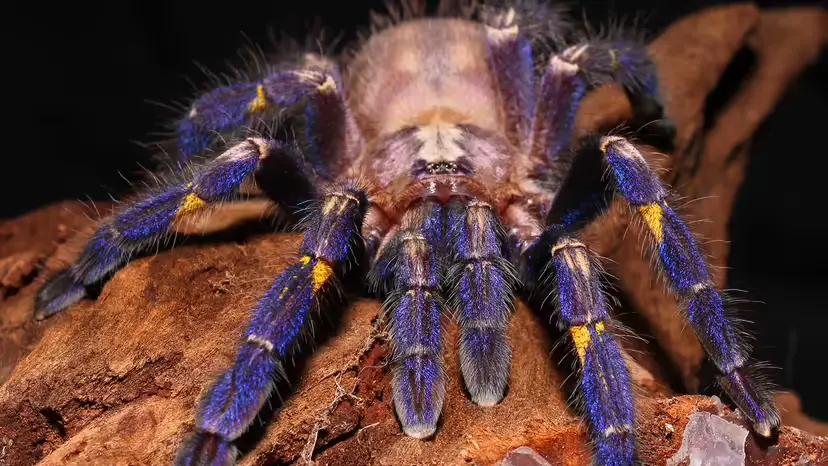Names: Gooty sapphire tarantula / Peacock tarantula; scientific name Poecilotheria metallica.
IUCN Status: Critically Endangered (CR). Wild range is extremely restricted to a small patch of forest in Andhra Pradesh, India.
Signature trait: Striking electric blue hair created by structural color (nano-scale light reflection), not blue pigment.
Ecology: A classic arboreal tarantula—nocturnal, denning in tree cavities with asymmetric funnel webs; specializes in flying insect prey.
Top threats: Habitat loss/fragmentation from logging and fuelwood collection, plus high demand in the pet trade.

Taxonomy: Araneae > Theraphosidae > Poecilotheria (ornamental tarantulas).
Size: Adult leg span 6–8 in (15–20 cm); females bulkier and longer-lived.
Look: Metallic blue carapace, dark abdominal patterning; vivid blue extends onto the undersides of legs with contrasting yellow/white “warning” patches.
Juveniles/subadults: Paler gray-blue overall; lower contrast markings.
Adult females: Robust build, saturated blue, crisp patterning; often live 10+ years.
Adult males: After the mature molt, bodies look slimmer; blue is less intense; pedipalps show swollen bulbous emboli (reproductive structures). Lifespan typically shorter.
Known wild range: A ~100 km² pocket of seasonal deciduous forest in Andhra Pradesh.
Microhabitat: Tree cavities/crevices, with asymmetric funnel webs that function as both hide and ambush platform.
Discovery note: Early records are linked to a railway timber yard in Gooty, hinting that historic human transport of timber may have moved individuals.
Activity: Primarily nocturnal; highly photosensitive and will flee from bright light. First response is escape; if cornered, it may bite.
Feeding: Ambush predator of flying insects (moths, beetles, etc.); short, explosive pounces from elevated hides.
Webbing: Lines the cavity and entrance to stabilize and create a versatile refuge/strike platform.
Medical significance: Bites from Poecilotheria spp. are associated with intense pain and autonomic-like symptoms (tachycardia, stinging, cramps, sweating, localized swelling). Fatalities are exceedingly rare.
Dry bites: Many bites are dry (no venom), but long fangs still cause mechanical injury.
Duration: Most cases resolve in days; severe cases may linger weeks to months.
Practical takeaway: Don’t handle. If you must move one, use gloves and a secure catch cup/tube.
The “sapphire” hue comes from nanostructured crystals/fibers that selectively reflect blue wavelengths—structural color, not pigment.
Leading hypotheses:
Sexual signaling at close range.
Intraspecific communication in dim forest light.
By-product of hair microstructure optimized for mechanics/insulation/water repellence.
No single hypothesis is proven—this is an active cross-field topic in materials science and behavioral ecology.
Market reality: Highly coveted for its color; captive breeding has been established for 10+ years. Prices may reach several hundred USD; slings are cheaper.
Husbandry snapshot:
Temp: 64–75°F (18–24°C); RH: 75–85%.
Enclosure: Tall, well-ventilated arboreal setup with vertical cork bark/tubes, snug hides, controlled humidity.
Diet: Primarily crickets; can take moths, roaches, grasshoppers (all from safe, pesticide-free sources).
Compliance & risk:
Buy legally sourced, captive-bred stock only; avoid wild-caught animals.
Check local regulations on exotic species and CITES/transport rules.
Not a beginner’s “hands-on” species—fast, skittish, defensive; best for look-don’t-touch keeping.
Primary threats:
Fuelwood harvesting/logging removing hollow trees;
Tiny range makes it vulnerable to wildfire/drought and other stochastic events;
Illegal collection for trade.
Priority actions:
Improve on-the-ground management of reserve forests (not just “paper parks”).
Support community energy alternatives to reduce pressure on standing deadwood and cavity trees.
Strengthen traceability and enforcement against illegal trade; keep markets to verifiable captive-bred animals.
Q1: What eats them in the wild?
A: Predatory birds, some reptiles, and larger arachnids. Bright coloration may raise detectability at close range, but deep cavities, shadow cover, and bolt speed mitigate risk.
Q2: How do they reproduce?
A: Post-maturity, males transfer a sperm packet via the pedipalps. Females may become aggressive afterward. Eggs are laid in a silk egg sac that the female guards; spiderlings (“slings”) undergo multiple molts to mature.
Choose legally traceable captive-bred animals only.
Keep them as display animals, not for handling.
Don’t purchase on impulse—be ready for long-term, species-appropriate care.
Support in-situ habitat protection and community programs in the native range.
animal tags: gooty sapphire tarantula
We created this article in conjunction with AI technology, then made sure it was fact-checked and edited by a Animals Top editor.